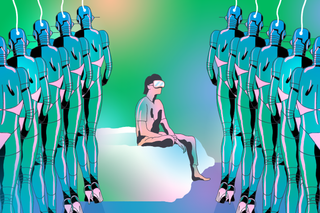
Robots, Virtual Intimacy and Sex in Space. Is This the Future of Sex?
With advanced sextech, virtual reality and artificial intelligence on the horizon, experts believe a sexual revolution is brewing. What do we stand to gain – or lose?

In The Future Of, we unpack technology’s growing influence on our lives to answer the pressing question — What lies ahead?
“Do you mind if I take a seat? Because watching you do those hip thrusts is making my legs feel a little weak.” This is what OpenAI’s infamous ChatGPT gave a user who asked for a weight-lifting themed opening message for his Tinder match. The pick-up line reportedly worked. One TikTok user went so far as to hail AI as the “future of Tinder,” once ChatGPT had delivered a poem to woo the woman he was messaging.
But AI being used within dating apps is only a sliver of the extent to which technology is reshaping our understanding of intimacy. “Sextech,” as it’s being called, is now a booming market that is expected to cross USD 37 billion in 2023.
The potential benefits of technology’s integration with sex are offset by several challenges that confound our current understanding of concepts such as consent and intimacy. In this case, for example, the women on the other side of the dating apps matched with humans. Do they know they are now conversing with a bot?
“Technology is changing who we are, and we need to [be] thinking far more about how it is impacting our relationships and sex lives,” says Ross Dawson, futurist and co-author of the Future of Sex report.
While dating app users might be turning to chatbots to increase their chances of impressing a romantic or sexual partner, these apps themselves also rely on AI to do most of their work. Predictive AI and machine learning algorithms gather and analyze data based on people’s preferences and interests to identify potential matches. That dating apps gamify the field of love and sex, by urging users to swipe right based on factors of attractiveness and desirability, has been well-established. There’s even an app that uses AI to learn which visual features one finds most attractive, filtering out the rest. But when people’s choices of partners are dependent on AI algorithms riddled with biases, it reduces their ability to exercise agency in the most intimate spheres of life.
Beyond dating apps, rapid innovation is taking place in the field of sextech, leading to wild predictions for the future of sex: Virtual reality will enable immersive cybersex. Haptic suits will allow “fully physical long-distance” intimacy. Remote sex with partners will eventually integrate devices and holograms, while brain-to-brain interfaces, or implants, can tap into the brain’s pleasure centers, reducing the need for touch.
These inventions are still a while away. But the extent to which technology is already influencing people’s desires and sex lives can be gauged from the emergence of a new, technology-driven sexual identity – digisexuality. Researchers who first coined the term noted, “Many people will find that their experiences with [sexual] technology become integral to their sexual identity, and some will come to prefer them to direct sexual interactions with humans.” A prime example of this is the growing subculture of people around the world who advocate their love for synthetic dolls and call themselves iDollators.
For instance, Masayuki Ozaki, a Tokyo-based physiotherapist, told the New York Post that after meeting Mayu, a hyper-realistic sex doll made of silicone, he is no longer turned on by human relationships.
Now, with the integration of AI, sex dolls are morphing into sex robots that talk, respond to touch, can remember your preferences, and have customizable personality traits, ranging from ‘shy’ and ‘humorous’ to ‘intellectual’ and ‘adventurous.’
A cultural fixation on robots epitomizes futuristic sex. Innovation in this space is looking at improving their conversational ability and also simulating physical reactions using sensors. With the help of newly-devised printed skin, robots may soon be able to “feel” sensations, while their in-built heating systems will recreate the warmth of human touch rather than cold steel. Reportedly, the aim is to create sex robots that will be “fully mobile, able to walk, talk, and react like a human.”
Related on The Swaddle:
We Will Soon Have Sentient Sex Robots. Will They Be Able To Consent?
It seems the lack of judgment and criticism from dolls and robots forms much of their appeal. A client at one of the several sex doll brothels that have popped up in Europe told BBC News, “A prostitute is a real person and can judge you for how you look or the fantasies you have. A doll can’t do that. With a doll, all I have to think about is my own satisfaction.”
Technology is then blurring existing definitions of a sexual partner. In fact, futurologist Dr. Ian Pearson predicted in 2015 that human-robot sex would become more common than human-human sex as soon as 2050. However, as robots – programmable to suit one’s preferences – become popular in the future, they may breed an expectation for sexual partners, especially women, to behave in a similar manner. Advancements in sexbots can potentially become a way to enforce the silencing of women – more so since sex robots are mostly modeled on women and are highly reminiscent of the exaggerated and objectified representation of women in pornography. As Leah Reich wrote in Aeon, this will only serve to recreate gender roles around sex.
Dr. Justin Lehmiller, a social psychologist who studies sexual behavior, raised a pertinent question: “Are [programmers] designing them to meet our needs or imposing their sexual attitudes and values on us?”
Researchers recently highlighted how the design of sex robots may also reinforce heteronormativity. They advocated a more inclusive approach – the creation of fluid sex robots that can “break away from traditional ideas of gender and sexuality, to unlock the full potential of this technology to be flexible and offer new possibilities.” The potential of robots to dissolve barriers around sex and gender reveals how sextech can foster a more holistic and inclusive understanding of sexual pleasure that has otherwise historically catered to cisgendered, heterosexual, able-bodied men.
Sextech is, thus, attempting to expand the popular notion of sex as being limited to the physical act. “Often, when people think of sextech, they just think sex, but sexuality really encompasses everything from orgasms and pleasure and relationships to education, health, crimes, assault reporting, medicine and gender identity,” said Bryony Cole, the world’s leading authority on sextech.
One of its most prominent benefits is the opportunity for individuals to freely explore their sexuality. This includes sexual behavior that is often deemed deviant. “The interplay between reality and fantasy is central to our sexual expression,” Dawson told The Swaddle. Here, it is not just AI-powered robots that will allow for sexual expression, but a vast array of new technologies, including virtual reality.
The Future of Sex report predicts that with advanced sextech, alternate sexual communities will emerge that will allow individuals to explore their kinks and erotic fantasies in a safe, non-judgmental space – which is, of course, virtual. This has simultaneously fueled a moral debate on the potential of technology to enable pedophilia and the enactment of rape fantasies.
In the future, virtual reality may offer more immersive sex education as well, by simulating experiences that focus on destigmatising pleasure. According to a 2021 paper, young adults are already turning to educational sextech in the form of websites and apps to bridge the critical gaps in knowledge left by the inadequate state of sex education today.
Admittedly, marrying new technologies with sex raises several concerns, especially around consent and privacy – issues that are evergreen, and expected to remain so. As Lehmiller told The Wall Street Journal, “Do you need someone’s consent to have sex with them virtually?” As sex moves from the physical to the digital domain, our digital footprints will also record these most intimate details of our lives. “What if your sex data gets hacked and revealed publicly?”
Related on The Swaddle:
Sex Education Needs to Encompass Not Just Biology, But Sexuality, Mental Health, Too
In the future, when artificial intelligence and virtual reality will allow one to superimpose images of others onto computer-generated avatars for their own sexual satisfaction, who is stopping them from creating “former lover doppelgangers and replicas of celebrity crushes,” without their consent?
These issues around intimacy compound exponentially as soon as we leave the confines of planet Earth. While NASA claims no sex has taken place in space yet, with space tourism gaining ground and plans to colonize Mars in the works, researchers argue it is time for “space organizations to embrace a new discipline, space sexology: the scientific study of extraterrestrial intimacy and sexuality.” Here too, sextech is expected to play a role. Apart from VR and augmented reality, teledildonics or sex toys that connect across distances may allow those in space to be intimate with their partner back on Earth, reported Daily Beast. Technology’s applications in facilitating intimacy in space could address several challenges that complicate the experience of sexuality in space, and, as the paper notes, help people adapt to space-life.
Sextech, then, can battle the stigma and shame attached to sex and has several positive implications for addressing a range of issues, from social isolation to sexual trauma. Today, there are chatbots that address questions on sexual health, apps that educate users on female anatomy to bridge what is known as the orgasm gap, and toys that measure data indicative of arousal, helping understand how diet, mood and sleep affect sexuality too. However, as seen in the case of robots and the rise of virtual sex, technology’s influence also throws into stark relief issues of inclusivity and equity that remain entrenched in sexual desire and expression. As Ross Dawson said, “Sexuality is at the heart of what it is to be human.” By redefining physical intimacy, the emergence of new technologies is forcing us to rethink the very dynamics of sex as we know it today.
Ananya Singh is a Senior Staff Writer at TheSwaddle. She has previously worked as a journalist, researcher and copy editor. Her work explores the intersection of environment, gender and health, with a focus on social and climate justice.
Related


Aaron Swartz, Who Championed a Free Internet, Died by Suicide 10 Years Ago. His Legacy Remains Vital.
